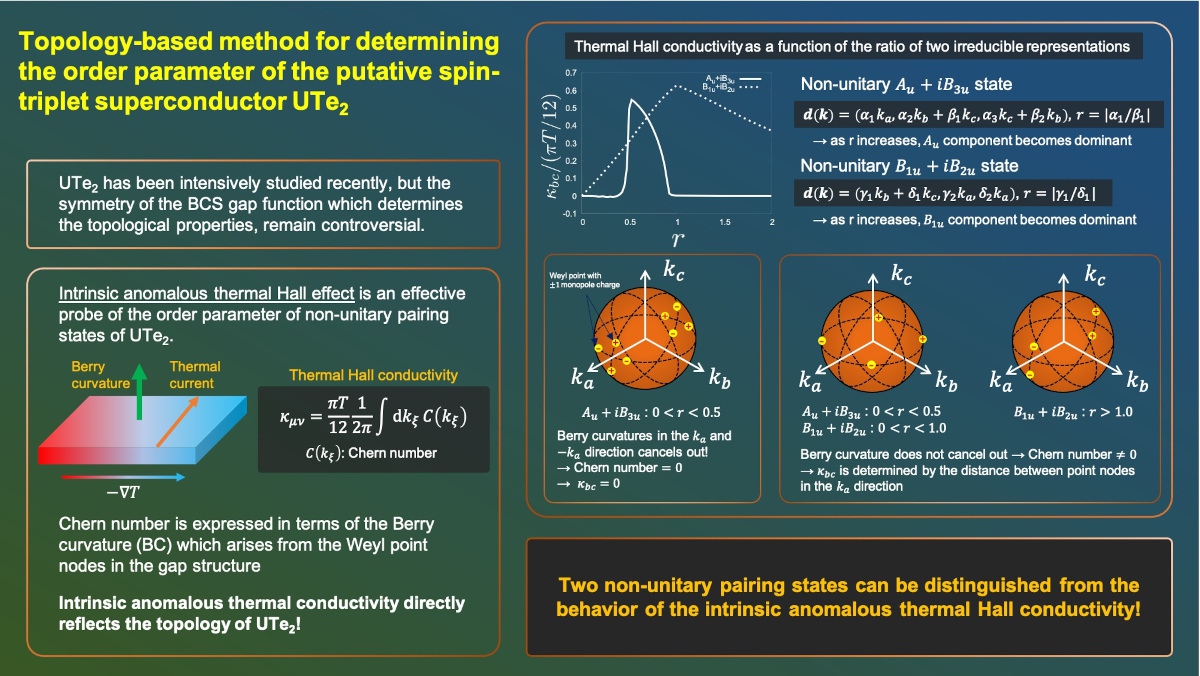Topology-Based Method for Determining the Order Parameter of the Putative Spin-Triplet Superconductor UTe2
© The Physical Society of Japan
This article is on
Intrinsic Anomalous Thermal Hall Effect in the Unconventional Superconductor UTe2
J. Phys. Soc. Jpn. 91, 094710 (2022).
The intrinsic anomalous thermal Hall effect can be an effective probe for the order parameters of non-unitary pairing states of the putative spin-triplet superconductor UTe2

Recently, the actinide compound UTe2 has been intensively studied as a novel candidate material for a spin-triplet superconductor, which is expected to host Majorana particles utilized for quantum computation. The superconductivity of this material without a magnetic order renders it ideal for research on pure spin-triplet superconductors. The possibility of a non-unitary pairing state in UTe2 is also discussed, indicating that UTe2 is a Weyl superconductor that has topologically protected point nodes with monopole charges in the superconducting gap. However, the symmetry and gap structures, which determine its topological properties, remain controversial. Therefore, an effective method for probing the order parameter of UTe2 is lacking.
In this study, the intrinsic anomalous thermal Hall effect, which is a fundamental property of Weyl superconductors, is investigated. The pairing state in the spin-triplet superconductor is characterized by a three-dimensional odd-parity order parameter, referred to as a d-vector. The basis of the d-vector corresponds to the irreducible representations (IRs) of the D2h point group. When symmetry is reduced by the application of an external field, the admixture of these IRs is formed, which results in non-unitary pairing. We calculate the thermal Hall conductivity for the possible non-unitary pairing states in UTe2 as a function of the ratio “r” of the amplitudes of two mixed IRs. The intrinsic anomalous thermal Hall conductivity can be obtained by the integration of the Chern number, which corresponds to an integration of the Berry curvature over the Brillouin zone. Since the Berry curvature arises from the Weyl point nodes with monopole charges, the intrinsic thermal Hall conductivity directly reflects the distribution of the point nodes on the Fermi surfaces.
The relationship between the Hall conductivity and the point node structure is evident in the case of a simple ellipsoid-shaped Fermi surface, which is the minimum model that reflects the orthorhombic crystal structure. The admixture of IRs causes a splitting of the point nodes, because of which they move away from the high-symmetry axis. When one point node splits into two, the split nodes become Weyl points that have monopole charges with opposite signs. In this case, a Berry curvature exists along a certain direction, with a finite Chern number. This results in a finite thermal Hall conductivity, the magnitude of which depends on the distance between the point nodes.
The change in the point node structure due to the admixture of the two IRs is unique for each d-vector and is useful for the distinction of the order parameters based on future thermal conductivity measurements.
(Written by Y. Moriya on behalf of all the authors.)
Intrinsic Anomalous Thermal Hall Effect in the Unconventional Superconductor UTe2
J. Phys. Soc. Jpn. 91, 094710 (2022).
Share this topic
Fields
Related Articles
-
Microscopic Exploration of Electronic States in Nickelate Superconductors
Magnetic properties in condensed matter
Superconductivity
2024-5-31
The multilayered nickelates, La3Ni2O7 and La4Ni3O10 , were investigated using nuclear magnetic resonance (NMR) at ambient pressure. Metallic electronic states under the density wave order were observed microscopically for both compounds.
-
Single-Crystal Growth of a Cuprate Superconductor with the Highest Critical Temperature
Superconductivity
2024-5-20
Millimeter-sized single crystals of a trilayer cuprate superconductor (Hg,Re)Ba2Ca2Cu3O8+δ that exhibits the highest superconducting transition temperature under ambient pressure, were grown reproducibly and safely.
-
Cooking in Salt for Ultra-Clean Superconductor UTe2
Superconductivity
2024-4-30
A new crystal growth technique, the molten salt flux liquid transport method, was developed to produce high-quality single crystals of spin-triplet superconductor UTe2. This method is promising for exploring the exotic superconductivity of other materials.
-
Exploring Electronic States in BEDT-TTF Organic Superconductors
Superconductivity
Electronic transport in condensed matter
Magnetic properties in condensed matter
2024-4-24
This review, published in the Journal of the Physical Society of Japan, provides a comprehensive summary of the electronic states observed in BEDT-TTF type organic superconductors, including metal-insulator transitions, Mottness transitions, non-Fermi liquids, quantum spin liquids, and Bose-Einstein condensation.
-
A New Superconductor Family with Various Magnetic Elements
Superconductivity
Cross-disciplinary physics and related areas of science and technology
Electron states in condensed matter
2023-10-27
A new superconductor family, Sc6MTe2, has been discovered, comprising seven variations with magnetic elements labeled as M. Notably, only a few known superconductor families exist that involve various magnetic elements.
